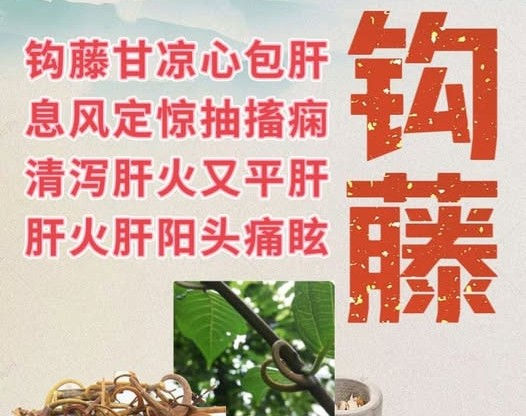Gou Teng: The TCM Herb for Calming the Liver and Easing Spasms
- Hongji Medical

- Jun 22
- 4 min read
Gou Teng, also known as Uncaria Vine or Uncaria rhynchophylla (and related species), is the dried, hooked stem of a plant in the madder family. Valued in Traditional Chinese Medicine (TCM) for its ability to clear heat, calm the liver, and stop spasms, it is widely used for conditions like dizziness, high blood pressure, and convulsions caused by liver hyperactivity or heat.
Gou Teng’s medicinal use is documented in ancient texts. The Kaibao Bencao first recorded it, noting its role in treating pediatric fever and seizures. The Bencao Tujing expanded its applications to adult dizziness and heat-related issues. In the Compendium of Materia Medica, Li Shizhen described its vine-like growth with hook-shaped thorns, emphasizing its ability to calm seizures, reduce heat, and relieve headaches. Gou Teng remains a key TCM herb for liver-related disorders.

Properties of Gou Teng
Nature and Channels
Taste: Sweet
Nature: Cool
Channels: Liver, Pericardium
Main Benefits
Clears heat and calms the liver
Stops spasms and convulsions
Lowers blood pressure
Reduces heat and toxicity
Dosage
Internal use: 6–12 grams, boiled in decoctions.
Growing Regions
Found in southern China, including Guangdong, Guangxi, Fujian, and Yunnan, harvested in spring or autumn.
Identification
Shape: Cylindrical or nearly cylindrical, 2–4 cm long, 0.5–1 cm in diameter.
Color: Brownish or grayish-brown surface with longitudinal wrinkles and lenticels.
Texture: Hard, not easily broken, with paired, conical hooks at nodes (often broken); yellowish-brown cross-section.
Scent and Taste: Mild scent, bland taste.
Preparation
Used raw or lightly fried. Raw Gou Teng strongly clears heat and stops spasms; light frying moderates its cooling nature.

Clinical Uses of Gou Teng
Gou Teng is used in TCM to treat various conditions:
Liver Yang Hyperactivity: Relieves headaches, dizziness, red face, red eyes, irritability, insomnia, high blood pressure, and a wiry pulse due to excessive liver yang.
Internal Liver Wind: Eases limb tremors, convulsions, or even fainting with clenched jaws from heat, liver yang, or yin deficiency.
Pediatric Convulsions: Treats fever-induced seizures or coma in children caused by heat and liver wind.
Preeclampsia in Pregnancy: Manages late-pregnancy symptoms like headaches, dizziness, blurred vision, or convulsions from liver hyperactivity.
High Blood Pressure: Lowers blood pressure, especially in liver yang-related cases.
Epilepsy: Helps control seizures to some extent.

Specific Benefits
Clearing Heat and Calming the Liver: Contains rhynchophylline, which lowers blood pressure and calms the mind, easing headaches and irritability.
Stopping Spasms: Suppresses liver wind, relieving tremors and convulsions.
Lowering Blood Pressure: Supports treatment of hypertension.
Reducing Heat and Toxicity: Alleviates heat-related symptoms.

Gou Teng in TCM Formulas
Gou Teng is often combined with other herbs in TCM formulas to enhance its effects. Here are some examples:
Ling Jiao Gou Teng Tang (Antelope Horn and Uncaria Decoction): Combines Gou Teng with Antelope Horn, Mulberry Leaf, Chrysanthemum, Rehmannia, White Peony, Fritillaria, Poria, Bamboo Shavings, and Licorice to clear heat and stop convulsions, used for fever-induced seizures.
Tian Ma Gou Teng Yin (Gastrodia and Uncaria Decoction): Includes Gou Teng with Gastrodia, Abalone Shell, Gardenia, Scutellaria, Eucommia, Achyranthes, Leonurus, Night Jasmine, and Poria to calm the liver and treat headaches, dizziness, and insomnia.
Zhen Gan Xi Feng Tang (Sedate the Liver and Extinguish Wind Decoction): Uses Gou Teng to nourish yin and subdue yang, addressing dizziness and tremors from liver yin deficiency.
Comparison with Similar Herbs
Gou Teng shares liver-calming properties with other TCM herbs but has unique strengths:
Tian Ma (Gastrodia): Strongly stops spasms and relieves pain, ideal for wind-related numbness and headaches, with broader pain relief than Gou Teng.
Shi Jue Ming (Abalone Shell): Calms liver yang and clears eye heat, best for red, swollen eyes and stronger yang suppression.
Ling Yang Jiao (Antelope Horn): Potently clears heat, calms seizures, and detoxifies, used for severe fever and convulsions, with stronger effects than Gou Teng.
Gou Teng’s focus on clearing heat and stopping spasms makes it ideal for liver wind conditions, while Tian Ma excels in pain relief and Shi Jue Ming in eye health.
Modern Applications and Research
Modern research highlights Gou Teng’s benefits:
Blood Pressure Reduction: Rhynchophylline lowers blood pressure, aiding hypertension treatment.
Sedative Effects: Calms the nervous system, improving sleep and reducing anxiety.
Anti-Convulsant: Suppresses central nervous system activity, easing seizures.
Anti-Inflammatory: Reduces inflammation in some conditions.
Heart Protection: Supports heart muscle function.
Gou Teng is used clinically for hypertension, stroke recovery, epilepsy, and mental health issues like anxiety and insomnia.
Precautions for Using Gou Teng
Cold Deficiency: Avoid in spleen-stomach cold or blood deficiency, as its cool nature may harm yang qi.
Non-Heat Conditions: Use cautiously if no heat or wind symptoms are present.
Short Decoction Time: To preserve active compounds, add Gou Teng in the last 5–10 minutes of boiling.
Bleeding Disorders: Use cautiously, as it may affect blood clotting.
Conclusion
Gou Teng is a vital TCM herb known for clearing heat, calming the liver, and stopping spasms. It effectively treats headaches, dizziness, convulsions, and high blood pressure caused by liver hyperactivity or heat. Modern research supports its blood pressure-lowering, sedative, and anti-convulsant benefits. Its cooling nature requires careful use in cold or non-heat conditions, and short boiling times preserve its potency. By consulting a TCM practitioner for proper dosage, Gou Teng can be a powerful remedy for liver and neurological health.




